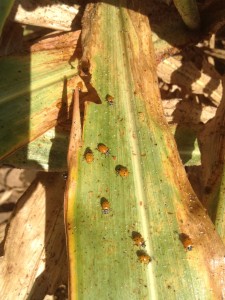This tip was provided by:
Calvin Trostle, Extension Agronomy, Lubbock, 806-746-6101, ctrostle@ag.tamu.edu
Statewide
Harvest Aids in Grain Sorghum—A Review
In the June 17 and July 1, 2014 (yes, a year ago) “Sorghum Tips” Dr. Ron Schnell and I discussed harvest aids in grain sorghum as well as desiccation. You can review that information at http://texassorghum.org/sorghum-tips/page/3 A 2003 Extension publication, “Harvest Aids in Sorghum” best accessed at http://publications.tamu.edu/CORN_SORGHUM/PUB_Harvest Aids in Sorghum.pdf, also discusses glyphosate and sodium chlorate and how they work in grain sorghum. We did not note in our above 2014 “Sorghum Tips” that Diquat 2L (Aceto) or RowRunner (Rotam), but not Reglone (Syngenta) (active ingredient is diquat dibromide), are labeled for seed hybrid grain sorghum production. Diquat acts similar to paraquat but is slightly less toxic (that is relative, still ‘skull-and-crossbones!), and it is used among other things on winter canola in Oklahoma.
Sodium chlorate a desiccant choice in fields with sugarcane aphid?
This product burns the leaves and will dry the head as well as the foliage whereas glyphosate may take up to a week to work, and it may not dry the head as much. This is our concern—sugarcane aphids looking for better quality forage for feeding might move or even be forced to the head. Sodium chlorate does not kill the plant, which could be a benefit if you have lodging concerns, but the product has its own safety concerns related to fire, and any sodium chlorate product should have a fire retardant in the chemical you buy. Sorghum will grow back, however, if not harvested in timely fashion after sodium chlorate treatment. If you use this chemical in a SCA-infested setting, I would like to hear of your experience.
A Short Update on Sugarcane Aphid in the Texas High Plains
Our Extension entomologists, farmers, etc. are reporting some odd observations. In spite of continued temperatures in the low 90’s and 65-70°F at night—conditions favorable for continued SCA development, it appears that in some fields SCA numbers are decreasing, and we have received reports where farmers believe there may be less than half of SCA numbers from just a week or 10 days ago. Likewise, a few surprises arise. For example, a farmer in Yoakum Co. with several thousand acres of grain sorghum, some planted as early as late April, other acres planted in June, has not sprayed a single acre as he never saw a major issue. Though he might have hit the technical thresholds, his fields (many different hybrids) never developed excessive numbers of SCA. He didn’t spray and it appears he will be OK. I will be visiting another field in Crosby Co. Friday where a farmer has had to spray four circles for serious SCA issues, but another adjacent hybrid has far fewer SCA, and he has not sprayed it. Wow! This is interesting. I will scout the field, record SCA numbers, etc.
Ladybugs like about all of us have never seen!…
I was in a field northeast of Lubbock on August 27 where aphids commonly ranged from 200 to 2,000 per leaf. I saw as many as 38 lady beetle adults on a single leaf, as many as four lady beetle larvae and 12 or more adults within a single head. This field had few winged adults. On Monday, August 31, the farmer called to say that with a light 0.2” shower over the weekend and all these beneficials, it appeared that SCA numbers were greatly less. Another interesting situation. He was preparing to spray either Transform or Sivanto, but now will not. This is one reason why we are fortunate these two insecticides are not damaging to beneficials.
Still making insecticide sprays for sugarcane aphid?—Silicone additives
Bayer and DowAgro both now recommend a silicone based adjuvant/surfactant to improve coverage. Examples of a few commercial names include ‘Airforce’ and ‘Syl-tac’.









